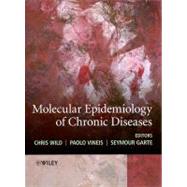
What is included with this book?
Professor Chris Wild. Molecular Epidemiology Unit, Head, Centre for Epidemiology and Biostatistics, Faculty of Medicine and Health, The LIGHT Laboratories, University of Leeds, UK.
Professor Paolo Vineis. Chair in Environmental Epidemiology, Div of Primary Care and Population Health Sciences, Medicine, Imperial College, London, UK.
Professor Seymour Garte. Professor of Environmental and Community Medicine, Robert Wood Johnson Medical School, University of Medicine and Dentistry of New Jersey; Scientific Director, Genetics Research Institute, Milan, Italy. Center for Environmental Oncology, University of Pittsburgh Cancer Institute, Pittsburgh,?PA,?USA.
| Contributors | |
| Artist statement | |
| Acknowledgements | |
| Introduction: why molecular epidemiology | |
| References | |
| Study design | |
| Introduction: study design at square one | |
| Epidemiological measures | |
| Bias | |
| Bias in screening practices | |
| More on confounding | |
| Specificities of molecular epidemiology design | |
| Special designs in molecular epidemiology | |
| Bias | |
| Selection bias related to sample collection | |
| Confounding and population admixture | |
| Mendelian randomization | |
| Conclusions | |
| References | |
| Essential reading | |
| Molecular epidemiological studies that can be nested within cohorts | |
| Introduction | |
| Case-cohort studies | |
| Design and calculable measures of effect | |
| Case-cohort designs offer flexibility | |
| Analytical complexity | |
| Nested case-control studies | |
| Design and calculable measures of effect | |
| Matching | |
| Counter-matching | |
| Individuals may be included in the analyses multiple times | |
| Considerations regarding biomarker analyses in case-cohort and nested case-control studies | |
| Batch effects | |
| Batch effects and case-cohort studies | |
| Batch effects and nested case-control studies | |
| Storage effects | |
| Storage effects and case-cohort studies | |
| Storage effects and nested case-control studies | |
| Freeze-thaw cycles | |
| Freeze-thaw cycles and case-cohort studies | |
| Freeze-thaw cycles and nested case-control studies | |
| Conclusion | |
| References | |
| Family studies, haplotypes and gene association studies | |
| Introduction | |
| Family studies | |
| Is there an increased risk of disease in relatives of cases? | |
| Is the familial aggregation due to genes or environment? | |
| What is the genetic mechanism? | |
| Where is the gene? | |
| Linkage analysis | |
| Example | |
| Genetic association studies | |
| Genetic case-control studies | |
| Bias and confounding | |
| Family-based study designs | |
| Haplotypes | |
| Reconstructing haplotypes | |
| Association studies with haplotypes | |
| SNP selection | |
| Whole-genome association studies | |
| Discussion | |
| References | |
| Individual susceptibility and gene-environment interaction | |
| Individual susceptibility | |
| Genetic susceptibility | |
| Metabolic susceptibility genes | |
| Study designs | |
| Gene-environment interaction | |
| Exposure dose effects in gene-environment interactions | |
| Mutational effects of gene-environment interactions | |
| Conclusions | |
| References | |
| Biomarker validation | |
| Validity and reliability | |
| Biomarker variability | |
| Measurement of variation | |
| Other issues of validation | |
| Measurement error | |
| Sources of laboratory measurement error | |
| Blood collection for biomarkers | |
| Validation of high-throughput techniques | |
| References | |
| Exposure assessment | |
| Introduction | |
| Initial considerations of an exposure assessment strategy | |
| Exposure pathways and routes | |
| Exposure dimensions | |
| Exposure classification, measurement or modelling | |
| Retrospective exposure assessment | |
| Validation studies | |
| Quality control issues | |
| References | |
| Carcinogen metabolites as biomarkers | |
| Introduction | |
| Overview of carcinogen metabolism | |
| Examples of carcinogen metabolite biomarkers | |
| Total NNAL (NNAL plus its glucuron | |
| Table of Contents provided by Publisher. All Rights Reserved. |
The New copy of this book will include any supplemental materials advertised. Please check the title of the book to determine if it should include any access cards, study guides, lab manuals, CDs, etc.
The Used, Rental and eBook copies of this book are not guaranteed to include any supplemental materials. Typically, only the book itself is included. This is true even if the title states it includes any access cards, study guides, lab manuals, CDs, etc.